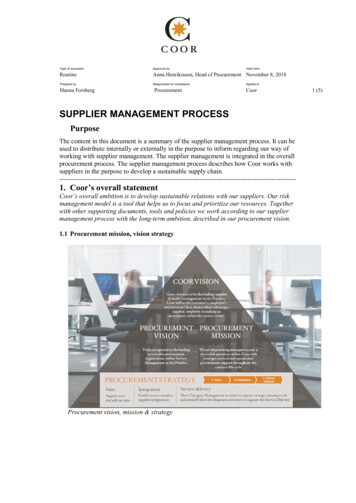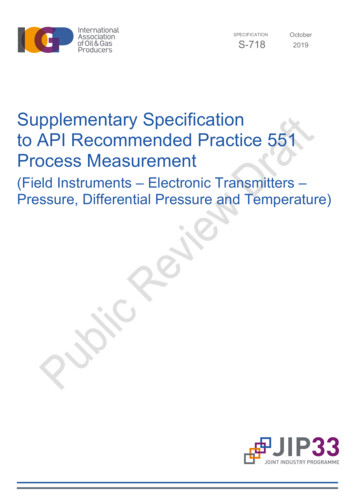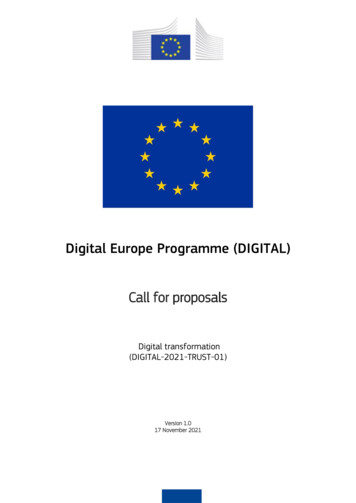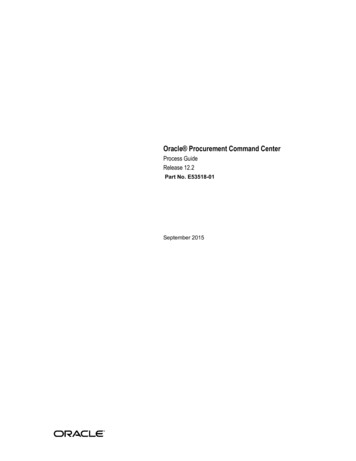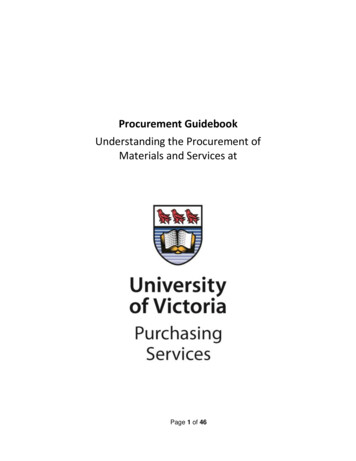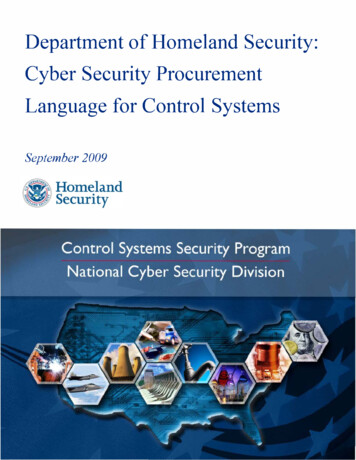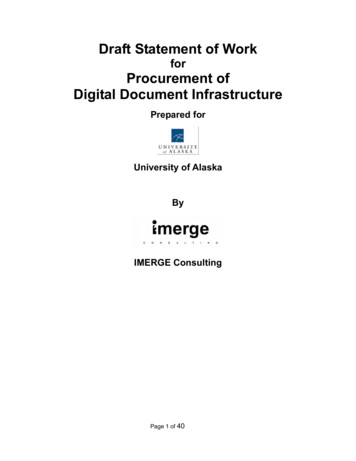
Transcription
Draft Statement of WorkforProcurement ofDigital Document InfrastructurePrepared forUniversity of AlaskaByIMERGE ConsultingPage 1 of 40
Table of Contents12Overview . 41.1Executive Summary. 41.2Procurement Process . 41.3Open Issues in Statement of Work. 51.4Draft Statement of Work Structure . 5Draft Statement of Work: Overview of Current Situation . 62.1University Overview. 62.2Information Technology Overview . 62.3Statewide . 62.3.1Current State . 6Server Platforms . 6Desktop Platforms . 6Network . 6Internet. 7Legacy Applications . 72.4Academic Campuses . 92.4.1Current State . 9Server Platforms . 9Desktop Platforms . 9Network . 9Internet. 9Electronic Mail. 9Legacy Applications . 92.5Project Overview . 102.5.13Timeframes . 10Draft Statement of Work: Scope of Services . 11Software. 11Hardware . 12Services . 12PROPOSAL FORMAT INSTRUCTIONS . 134Draft Statement of Work: Professional Information. 14Page 2 of 40
54.1Company Information. 144.2Proposed Team . 144.3References . 14Draft Statement of Work: Functional Requirements . 15General System Requirements. 18Imaging. 20Electronic Document Management . 24Records Management . 25Workflow . 27System Management. 31Security . 33Compliance . 33Hardware. 34Services. 35Installation. 35Integrations and Custom Applications . 36Technical Support . 36Training and Documentation. 37Warranties and Maintenance . 376Draft Statement of Work: Pricing. 39Pricing. 39Page 3 of 40
1 Overview1.1Executive SummaryOver the past few years, the University of Alaska has encountered a number ofproblems due to the lack of an organized record management program. UAF wascriticized in its last accreditation report regarding its maintenance of historic academicrecords. UAS barely avoided the flooding of its document “vault” several years ago.Statewide’s microfilming operation and document storage areas are not able to meetthe demand for processing HR and other records.In addition to the observed problems, as the University continues to implementelectronic solutions, such as Banner, web portals and process automation, the potentialbenefits of using and managing documents in digital form has become apparent.This document contains a draft for the Statement of Work section of an RFP to procuredigital document technology to build an infrastructure that may be used to addressthese and other needs.1.2Procurement ProcessThis Statement of Work is structured with the following assumptions about the futureprocurement:1.No need to replace Quest Vista Plus as the ERM solution.2.Open vendor shoot-offIt permits the comparison of other solutions with opting for Laserfiche orDocumentum, each of which the University already has some licenses for.3.That, since the deployment of SCT Workflow has not begun, vendors may optto recommend a replacement that fits better with the document repository.4.The University will purchase and install any hardware; the vendor will installany software, and configure the first application (Admissions).The University will need to review this document, and make any changes it deemsappropriate to the Mandatory / Optional designations.The procurement selection team should include representation from the following areas: Several Academic and Research Centers Enrollment Management: Admissions and Financial Aid Finance Grants Management (Office of Sponsored Programs) Human Resources ITS: Banner Support and Networking Records ManagementPage 4 of 40
A lead individual should be designated and chartered to take responsibility for managingthe procurement effort.This is a strategic infrastructure procurement, with a number of features listed that willnot initially be required, and there are options for vendors to use or replace existingUniversity licenses. Therefore, the University should expect this procurement to beinvolved and challenging. Comparing the responses will require several weeks offocused attention by the selection committee.1.3Open Issues in Statement of WorkThe following items are incomplete in the statement of work as provided, and will needto be resolved by the University before it issues an RFP:1.Whether it should implement one or two digital document repositories.2.The number of seats to be enabled for each implementation phase.3.Whether or not to procure hardware as a part of the RFP or separately, andwho should install the new hardware.1.4Draft Statement of Work StructureThe Statement of Work that follows is broken into the following sections: Overview of Current SituationThis section states the current technology, and the problems being addressed bythe procurement. Scope of Services RequestedThis section provides an overview of what is expected from the vendor. It isintended to enlighten the checklist in the functional requirements. Response:o Professional InformationInformation about the bidder and the vendors he is proposing.o Functional RequirementsDetailed feature requirements (both optional and required) for proposedsolutions.o PricingCost information.The University will want to make a number of documents available on the internet forbidders to review, including appropriate Banner and SCT Workflow documentation, andUniversity LAN and WAN details.Page 5 of 40
2 Draft Statement of Work: Overview of Current Situation2.1University OverviewThe University of Alaska comprises all public undergraduate and graduate schoolswithin the state. The University is organized into four units: Three major administrativeunits (MAUs) and statewide administration. The three MAUs are Fairbanks, Anchorageand Southeast (Juneau). Each MAU consists of a major campus and a number ofsmaller remote campuses. More details may be found by examining the University’sinternet site at (http://www.alaska.edu ).The University operates in a highly distributed manner, with statewide administrationproviding central services and acting to coordinate similar activities across the system.2.2 Information Technology OverviewThe following is a brief review of the technologies and systems in use within theUniversity of Alaska organization.2.3Statewide2.3.1 Current StateServer PlatformsThe current primary server platform for statewide production systems is HP Tru64running on HP Alpha machines (Digital Equipment legacies). The target server platformfor transitioning statewide systems over the next five years is HP/UX running on HPItanium servers. Oracle is used by all of the enterprise systems and would be thepreferred database for any new applications.The Arctic Region Supercomputing Center operates several supercomputers located inthe Butrovich building in Fairbanks. The ARSC systems are used for funded researchprojects. Access to these systems is through the system LANs and WANs.Desktop PlatformsA variety of Windows on Intel PCs and Apple MacIntosh computers are in use. There isno organized plan for replacement of desktop systems; therefore, a broad range ofdesktop capability must be supported.NetworkThe internal network uses TCP/IP and related protocols. Access is provided using802.11b wireless connections and switched wired connections at either 100 or 10megabits per second that are run to selected desktops. Two different wireless networksare deployed – one for general usage which does not have encryption, and a secondwhich uses 128 bit WEP.The University WAN uses Fairbanks as a hub. The major campuses of the University –Anchorage, Fairbanks, and Juneau – are connected by OC-3 WAN links. Frame relayPage 6 of 40
fractional T1 links running approximately 786K bits per second are used to connect toremote campuses.SUN LDAP is used for directory services by applications that can support it. A unifieddirectory is being developed.InternetAll campuses connect to the Internet through a connection to the WAN hub inFairbanks.Legacy ApplicationsA large number of applications are in use by the University. The following list highlightsthe major solutions that may require integration to a digital document repository, orimpact the solution choosen.BannerThe University deployed SCT Banner as a systemwide solution in 1996, and has addedmodules since that time. Banner now handles admissions, course registration, billing,academic records, and all internal financial activities.Access to Banner is provided through Citrix remote terminal software. Banner is fed byother internal systems, such as the UAA Gradelink system. Banner transactionworkflow, QuickFlow, has been purchased but not implemented.Vista PlusThe University is using the Quest Vista Plus 4.3 ERM system to store and managereports from the Banner system. This has reduced the need to print and distributepaper reports, and provided end-users with the ability to selectively print reports whenneeded. After a certain number of days reports are compressed using ZIP algorithmsand then backed up to tape. The University is considering upgrading to Release 5,which uses a new Java-based interface.The principal users of Vista Plus are Human Resources and Finance.Financial Edge and Raiser’s Edge The UA Foundation and the various Development offices use Blackbaud FinancialEdge and The Raiser’s Edge to manage their activities and funds. Information ismanually transferred from these systems to Banner.Risk Management DatabaseThe Risk Management department uses a homegrown application based upon RBASEand Visual Basic, which generates reports in Microsoft Excel format.LANDVIEWLand Management is using a custom built and outside hosted application calledLandView to store its documentation (primarily Adobe Illustrator files).Page 7 of 40
PathloreCorporate Programs is using the Pathlore Learning Management System to manageprofessional and continuing education records.EMASEMAS Pro from Educational Systems, Inc is being used to manage recruitmentefforts.ELMAll campus Financial Aid departments use ELM Resources to automate Federal FamilyEducation Loan Program (FFELP) and private loan processing through the Internet.eVision FormFusionFormFusion has been purchased but not implemented as a tool to reformat Bannerreports.Web PortalThe University has applied the SCT Banner Web product to support its’ first generationweb portal, UA Online. This is being used to permit a number of self-service functionsunder a secure area (“Wolflink”) which include online registration and grade checks.The other functions of UAOnline are: Apply for Admissions Distributed Education Gateway Financial Aid Info Information for Tax Credit (1098T) Transcript Requests Transfer Credit Resource Site Campus List Employment Opportunities Student Feedback Employee FeedbackStatewide has just begun deployment of SCT Luminis as a part of the MyUA portalproject, which is intended to wrap UA Online functions and other capabilities into asingle, user-manageable interface to information.Web Content ManagementStatewide is currently using Roxen CMS to support the UA Online project.The SCT Luminis product, which has been selected for the MyUA project, containslicensed components of Documentum’s Documentum 5 ECM platform for webPage 8 of 40
content management. The University has an enterprise license for Luminis. The MyUAteam plans to deploy this component late in their project schedule (late 2005).WorkflowThe University has an enterprise license for the SCT workflow product, and is currentlyattempting to pilot automation of several administrative processes.2.4Academic Campuses2.4.1 Current StateServer PlatformsServers are a variety of platforms, with the majority appearing to be Microsoft Windows,Intel architecture based.Desktop PlatformsDesktops are a mixture of both Microsoft Windows and Apple Macintosh systems, witha variety of hardware and chip generations.NetworkThe UAF LAN is described as operating at its limits, with occasional outages.All campuses raised bandwidth to their remote campuses as a problem. One of theexplanations given was the increasing use of streaming video for remote learning.InternetThis is covered as a part of the Statewide review. All campuses are finding increasingInternet usage due to student downloads and access to streaming media.Electronic MailA variety of electronic mail servers are being used by the campuses. In some cases,multiple servers are in use within one campus. Most implementations are usingMicrosoft Exchange. There is no consistent electronic mail naming convention.Legacy ApplicationsLaserFiche (UAA)The Anchorage campus has deployed a small LaserFiche imaging system to handleAdmissions related paperwork. The system has licenses for 25 full function stations,and 15 simultaneous viewers. It runs on a Microsoft Windows 2000 server using aMicrosoft SQL Server database. The server has 36 gigabytes of RAID 5 storage, whichis about ½ filled with 150 thousand pages.If this system continues to be a part of the University’s digital infrastructure, severaltasks will need to be performed.Page 9 of 40
Gradelink (UAA)Currently, UAA uses the Gradelink web-based online grading system to collect gradesfrom instructors. Grades are submitted on optical mark sense (OMR) forms and readusing recognition software. The grades are then fed electronically into the systemwideBanner system. Gradelink operates on a Microsoft Windows platform.Web PortalMost campuses, large or small, design and operate their own web site. These websites are independently managed, and use different server products. Often, these sitesact as front-ends to common functions, such as the distance learning system,UAOnline, and Wolflink.Collaboration ToolsAnchorage provides a web site called UAAOnline to provide access to Blackboard fordistance learners.2.5Project OverviewThe University of Alaska wishes to establish a strategic partnership with a vendor for itsdigital document needs. The initial focus will be on document imaging, with laterattention on process automation and web content management.The implementation of products will be completed in four major phases:Phase 1 will involve enhancing the Enrollment process, including Admissions andFinancial Aid, with scanning and electronic folders. As a future step, workflow will beadded to automate the review process.Phase 2 will address automation of the research grants and contracts processes.Phase 3 will address automation of a number of University-wide approval processes,including Accounts Payable, Human Resources functions, and ExpenseReimbursement.Phase 4 will use the base of digital document technology to permit departmentalsolutions to be implemented as deemed appropriate.In parallel, the University is initiating a formal records management program. Recordsadded to the new system will have retention assigned, and it is expected that it willpermit their monitoring and control. This solution should allow us to meet regulatoryrequirements for record retention and scale for future growth.2.5.1 TimeframesPhase 1 is expected to start within one month of vendor selection, and take no longerthan three months. The entire rollout is expected to span a period of at least threeyears.Page 10 of 40
3 Draft Statement of Work: Scope of ServicesThe procurement and implementation of an integrated electronic documentmanagement system, referred to in this document as the “Proposed System”,encompasses the scope of services for this RFP. Functionality desired as aresult of this acquisition includes the requirements outlined below and as definedin the Functional Requirements table. Since the University is intending to pick astrategic vendor for the construction over time of a digital document technologyinfrastructure, a number of features are listed which will not initially be procured.Software ImagingThe University needs to support a range of scanning options, includingdifferent densities and document sizes. The vendor should identify the imageenhancement capabilities of the capture systems. While most documents areblack and white and 8 ½ inches by 11 inches in size, it must be able to: Capture photographs, Capture documents that are not black on white, and Scan documents sized between 8 ½ inches to 14 inches and slipssmaller than a standard check.The University needs to retain and access student records and documents forthe life of the institution. Therefore, the solution proposed should support thegeneration of archival film, either through a connected device or the use of anoutside service bureau.The entire system should be integrated with the University’s technologyinfrastructure in the following ways: Users should only need to supply a single logon once to access systems. SCT Banner screens should be image enabled, so that a function key willprovide access to the relevant stored images. The solution may notrequire changes to the Banner user interface or screens. Document capture should validate against Banner data.Electronic Document ManagementThe University would like to use the proposed solution to store desktop files,such as those produced by word processing, spreadsheet, and graphicstools. WorkflowPage 11 of 40
The University’s current expectation is to continue to use its enterprise licenseof SCT Workflow, which is a stand-alone product. A vendor may propose areplacement product, but it should be priced separately, and a casepresented for replacing it. In addition, a solution for integration of thealternate with SCT Banner should be presented. Enterprise Report ManagementThe University’s current expectation is to continue using Quest Vista Plus forits print management and ERM needs. No current requirement is observed tolink Vista Plus with any of the digital document infrastructure. A vendor maypropose a replacement product, but it should be priced separately, and acase presented for replacing Vista Plus.Hardware The University is currently planning to procure all hardware separately fromthis RFP. Provide hardware (or specifications for hardware) for all necessarycomponents including, but not limited to, the following: Desktops, both MS Windows and Apple Macintoshes (specifications only) Server(s) (specifications only) Scanners Other hardware identified by the vendorServices Perform setup of the Proposed System (software and hardware), andconfiguration of the first applications. Possibly provide system integration with Banner. Train selected staff on all aspects of the system from end-user to systemadministration functions. Provide customized documentation. Provide on-going support services.Page 12 of 40
PROPOSAL FORMAT INSTRUCTIONSProposers must follow the following format for their responses, or risk being deemedunresponsive, and their proposal rejected. Submissions should be on 8 ½ x 11 inchpaper, single sided, and all pages should be bound or fastened to prevent pages frombeing lost. Please use a single font in 12 pt size for all text. The professional section of the response, which covers vendor information, staffing,and references. The technical section of the response should be arranged as follows: 1)Narrative description of the proposed solution (please limit this to no morethan three pages)2)Response to the Functional Requirements, in the order supplied below.The Pricing sectionPage 13 of 40
4 Draft Statement of Work: Professional Information4.1Company InformationPlease provide the following information on your company: Legal structure and ownership. Senior Management. History, including years in business, and predecessor companies or names. Financial status (D&B number or other credit history). Information on all proposed products and their vendors:o Years in Businesso Years product has been available4.2Proposed TeamPlease identify the staff you are proposing to install, configure and train University staff.Provide resumes for each individual, and specific experience relevant to this project.Describe project organization, and4.3ReferencesProvide at least three references for projects of similar size and duration.Please indicate your experience with serving institutions of higher education.Page 14 of 40
5 Draft Statement of Work: Functional RequirementsProposers will answer the following requirements in sequence, providing the section and item number with eachresponse. The table format given is not required. Each answer should start with one of the following responses:Yes - The proposed system currently meets all the requirements of the section and is included in the proposedsystem, at the proposed cost. Note: It is not acceptable for the vendor to answer “Yes” to a specification when thefunctionality exists only in a product currently in development. It is expected that any yes answer will befunctionality currently installed and running at an agency where a site visit could be performed.No - The proposed system does not currently meet all of the requirements of the section, the non-complyingfunctionality is not included in the proposed solution, and the vendor does not anticipate development to addressthis requirement.User The user can provide this functionality using commercially available tools, or tools proposed. The tool andconfiguration settings required to provide the functionality must be described.Alternate (Alt) - The proposed system meets the intent of the section but does not accomplish it in the samemanner as it has been described. Provide a description of the method in the “Description” column foraccomplishing the requirement. If necessary, attach a separate addendum (with the appropriate line referencefrom the spreadsheet) to the end of the section explaining in detail how their product meets the intent of therequirement.Modification Required (MR) - The proposed system does not currently meet all the requirements of the section, butthe vendor will address the requirement through new development. When using this answer the vendor iscommitting to deliver the function as a part of this project (i.e. it is required for final acceptance). If the vendor ischarging the participating agencies for developing this functionality the additional cost shall be clearly stated in apricing proposal.(F) – A planned and scheduled future release of the product will provide this functionality. The announced releasedate, any additional charge to obtain the feature and costs for additional items required for the function must beprovided. If mentioned in the quote, delivery of the functionality will become a contractual obligation if the proposalis accepted.Page 15 of 40
The response should be followed by a description of how the requirement is satisfied.There must be an answer supplied in both the “Response” and “Description” entries for each line item.Page 16 of 40
Item Numbers followed by an “M” are mandatory requirements; responses which do not provide the feature are notacceptable. Those followed by an “O” are optional; responses which do not support the feature are acceptable.Response Key (As explained above):Y This feature is provided.N This feature is not provided.U The proposed user tools can be used to include this feature.A Alternative method proposed to satisfy requirement.F There is a future plan to provide this feature - include and note anticipated release date.M Modification would be required at an additional cost. Costs, itemized per customization, must be provided in the costproposal.Comments: Add short comments in this column indicating how the requirement will be met. Extended comments maycross reference additional documentation. Cross referenced material must be clearly identified or it will not be consideredin your response.Page 17 of 40
RequirementResponse(Y,N,U,A,F,M)1.General System Requirements1.1.MSystem Architecture1.2.MRequired supportingsystem features1.3.MSystem is compatible with the existing Universitynetwork and operating systems.Pleasedescribe the recommended operating system.1.4.MSystem uses a database compatible withUniversity infrastructure. Oracle is preferred.Specify product recommended and versions1.5.MSpecify storage required, divided by software,database, and document storage.1.6.MSystem can grow from ? users to ? users?How?1.7.MSystem can grow from 100,000 documents tomillions? How?1.8.MDescribe desktop environments supported.1.9.MSystem supports MS Windows,Macintosh, and Citrix clients.software or operatingPage 18 of 40AppleorComments(Response required for all entries except“N”)
RequirementResponse(Y,N,U,A,F,M)1.10. MStandard TIFF Version 6, multi-page imageformat with CCITT G4 Facsimile compressionmust be used. Vendor will discuss variancesfrom this standard. TIFF must be viewable instandard windows and web TIFF viewers.1.11. MScanned document image storage, retrieval andbackup must be tightly controlled by theProposed System. Describe how your solutionmanages images, the ability of the image files tobe manipulated with standard operating systemtools and the backup method controlled by thesystem.1.12. MSystem integrates with Sun Directory Servicesor LDAP to provide single logon.1.13. MSystem integrates with SCT Banner screens.1.14. MSystem is easy to configure and administer.1.15. MSystem provides support for image to film.1.16. MList any other products required for desiredfunctionality.Page 19 of 40orComments(Response required for all entries except“N”)
al Features2.1.1. MHas hierarchical storage support.2.1.2. MHolds enough media to hold 2 years ofdocuments online.2.1.3. MSupports the generation of archival film2.1.4. MThe system must support centralized anddistributed scanning and centralized anddistributed indexing in any combination.2.2.Document Capture - Centralized2.2.1. MSolution permits scanning of documents siz
Banner The University deployed SCT Banner as a systemwide solution in 1996, and has added modules since that time. Banner now handles admissions, course registration, billing, academic records, and all internal financial activities. Access to Banner is provided through Citrix re



